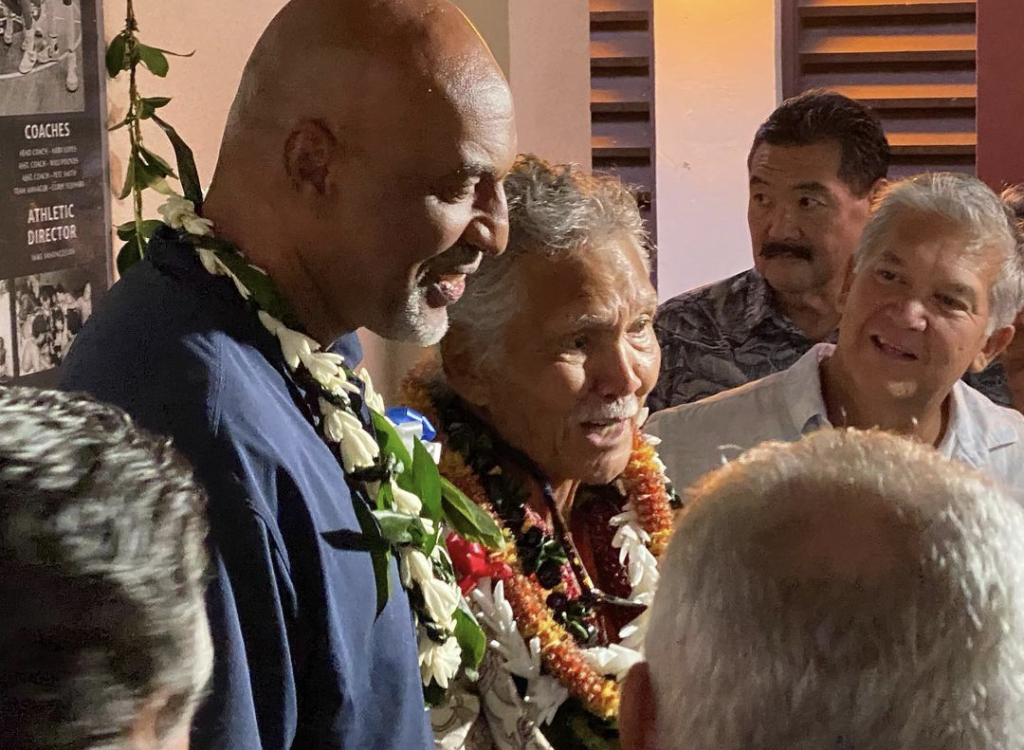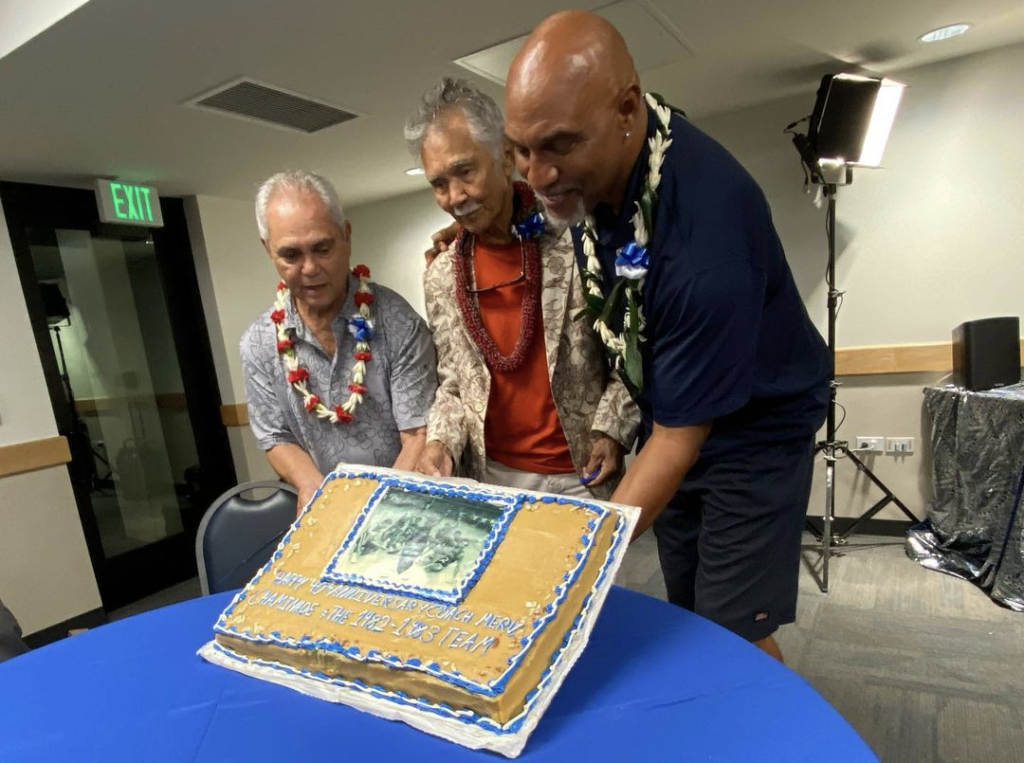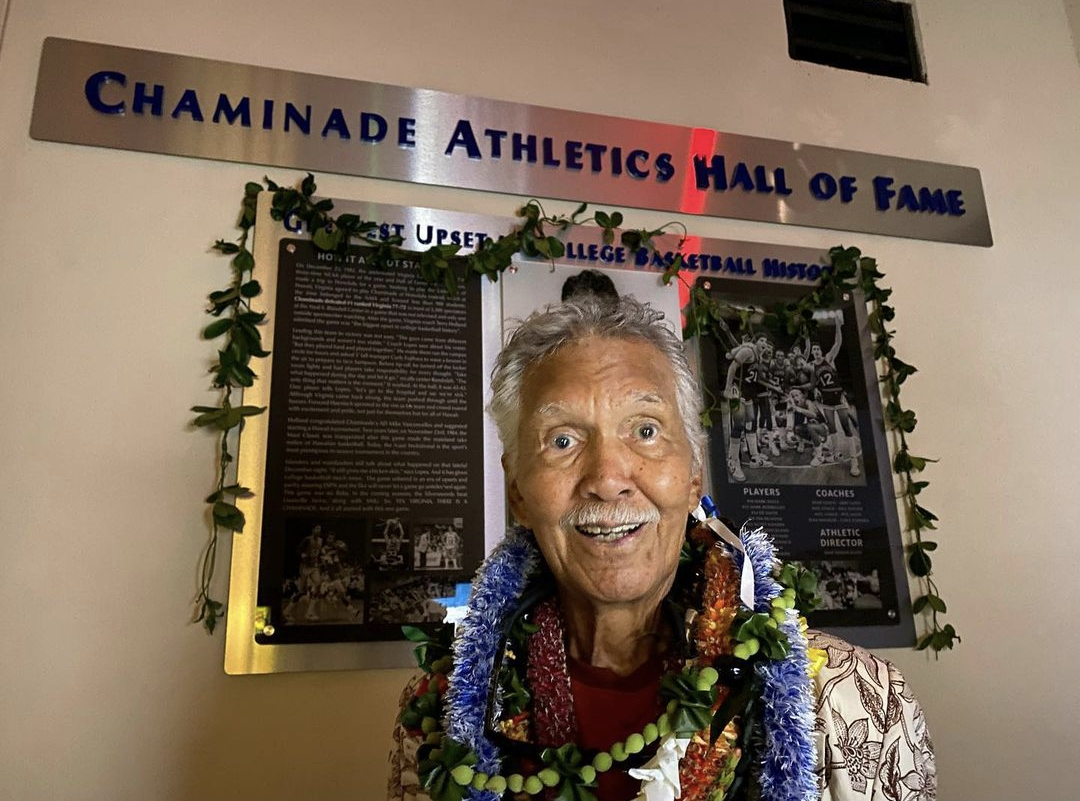Wednesday, December 7, 2022
Written by: Wes Nakama
Some forty years later, memories of the biggest upset in college basketball history are still crystal clear in the minds of the 3,383 who were in attendance at Blaisdell Arena on Dec. 23, 1982 to watch tiny Chaminade shock No. 1-ranked mighty Virginia, 77-72.
And thanks to a sparkling new Hall of Fame display outside McCabe Gym that was unveiled Friday evening, those memories will last another 40 years and beyond for everyone else.
At the center of that huge Virginia upset — and the Hall of Fame display — is legendary coach Merv Lopes, who built the fledgling Silverswords program into a small college power and earned them the nickname of “Giant Killers” after subsequent upsets of nationally ranked Louisville (twice) and Southern Methodist.
After the unveiling of the display, which is located on the mauka side of McCabe, next to the Chaminade Athletic Training room, Lopes was honored with a festive nearby campus reception attended by dozens of Chaminade staff, alumni and supporters.
“What made our team so special to me, was how Coach stressed to us that no one player is greater than the team, and on any given night, we could beat anybody,” said Tony Randolph, the Silverswords’ 6-foot-6 center who outplayed Virginia’s All-American Ralph Sampson in that historic upset. “He taught us to believe in ourselves, and in one another. Therefore, we believed, and thus, we became Giant Killers of college basketball.”
Sol Batoon, who was an assistant coach at Chaminade in the 1980’s, said Lopes’ talent and influence went far beyond X’s and O’s.

“”This was the true essence of Coach Merv Lopes’ leadership — he was about influencing human beings, bringing everyone together for a common cause,” Batoon said. “As coaches and athletes, this is what we aspire to be. Coach pushed us to be the best that you can be.”
After being given the microphone, Lopes shared the story of his humble background as a scrawny teenager from Nanakuli who was given the opportunity to attend ‘Iolani School and play football, basketball and baseball for legendary coach Father Kenneth A. Bray.
“Father Bray was an unbelievable man,” Lopes said. “He was a priest for St. Andrews (Cathedral), and he coached three sports, this guy. My senior year, we won them all (ILH championships in each). There’s nobody (else) who can do that. … I went to ‘Iolani, and Father Bray saved my life. He gave me the opportunity to go to ‘Iolani School, which was all smart guys.”
In particular, Lopes said the lessons of tough-love discipline and respect that Bray instilled were life-changing.
“That started it all for me,” Lopes said. “I never forgot that. Father Bray was the guy who did it all for me. From the beginning, to what is happening here today … How do you go from there, to here? It is amazing.”
Lopes went on to play football at Compton Junior College and San Jose State, where he was a teammate of future four-time Super Bowl champion coach Bill Walsh, and then returned to Hawai’i to start a career in the Department of Education. He coached Kailua High School to its first basketball state championship in 1972, and then guided Kalaheo to its first OIA title in 1976 before taking over the reigns at Chaminade, which had just started its program.
Lopes quickly built the Silverswords into a small college power, reaching the NCAA Division III and NAIA national tournaments several times and finishing with a school-record 238 victories and .669 winning percentage over 12 seasons.
And he did it with an effective mixture of local and Mainland talent.
“We had five (local) high school guys on that (1982-83) team,” Lopes said. “And people said, ‘Hawai’i has no basketball players’? C’mon, man.”
Randolph said Chaminade had no recruiting budget, but Lopes was able to find just the right type of players to fit the program.
“It was very diverse, there weren’t many teams that had that kind of mixture,” Randolph said. “There was such chemistry, and that was definitely a key to the success we had.”

Lopes also was a key coach and organizer for Pete Newell’s renowned “Big Man’s Camp,” and conducted many other clinics around the state long after his tenure at Chaminade, including Special Olympics.
And just like Bray, Lopes instilled lifelong lessons in all of the players he coached, from high school underclassmen to college seniors.
“He challenged us mentally and physically,” Randolph said. “The discipline that it takes can apply to all of us. No matter what job or what profession we take, if we apply the discipline to it, more times than not, we will be successful. We bought into that, and I think that had a lot to do with our success.”
And of course, through those magical upsets in the 1980s, Lopes and his Silversword Giant Killers inspired the entire nation by showing that it is possible to overcome seemingly impossible challenges.
“The upsets — that was by the grace of God, and a reminder to all of us that the odds can be stacked against you, but if you believe in yourselves and play together and give it all you’ve got, you can come out on top,” Randolph said. “It just so happened the stars lined up for us in the Virginia game, and we felt we had the crowd and the state of Hawai’i behind us. And so we gave it all we had, and we were very fortunate. From there on, we knew no matter who we played, we had a chance to win.”





